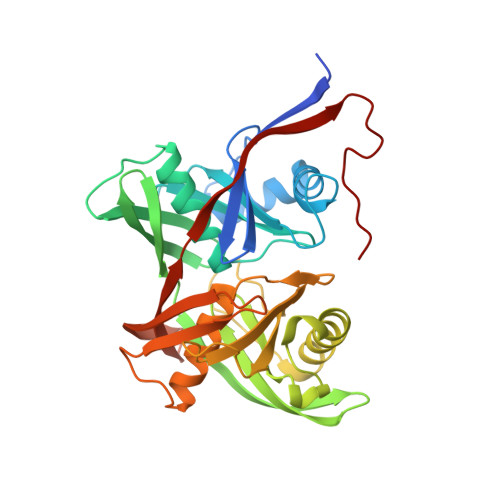Crystal structure of substrate-bound bifunctional proline racemase/hydroxyproline epimerase from a hyperthermophilic archaeon.
Watanabe, Y., Watanabe, S., Itoh, Y., Watanabe, Y.(2019) Biochem Biophys Res Commun 511: 135-140
- PubMed: 30773259
- DOI: https://doi.org/10.1016/j.bbrc.2019.01.141
- Primary Citation of Related Structures:
6J7C - PubMed Abstract:
The hypothetical OCC_00372 protein from Thermococcus litoralis is a member of the ProR superfamily from hyperthermophilic archaea and exhibits unique bifunctional proline racemase/hydroxyproline 2-epimerase activity. However, the molecular mechanism of the broad substrate specificity and extreme thermostability of this enzyme (TlProR) remains unclear. Here we determined the crystal structure of TlProR at 2.7 Å resolution. Of note, a substrate proline molecule, derived from expression host Escherichia coli cells, was tightly bound in the active site of TlProR. The substrate bound structure and mutational analyses suggested that Trp241 is involved in hydroxyproline recognition by making a hydrogen bond between the indole group of Trp241 and the hydroxyl group of hydroxyproline. Additionally, Tyr171 may contribute to the thermostability by making hydrogen bonds between the hydroxyl group of Tyr171 and catalytic residues. Our structural and functional analyses provide a structural basis for understanding the molecular mechanism of substrate specificity and thermostability of ProR superfamily proteins.
Organizational Affiliation:
Department of Bioscience, Graduate School of Agriculture, Ehime University, 3-5-7 Tarumi, Matsuyama, Ehime, 790-8566, Japan; Faculty of Agriculture, Ehime University, 3-5-7 Tarumi, Matsuyama, Ehime, 790-8566, Japan.















